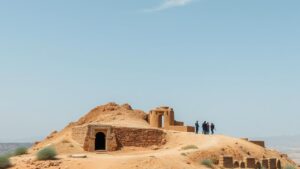Tracking gold-laden rivers from Inca legends to their unspoiled sources.
Tracking Gold-Laden Rivers: From Inca Legends to Their Unspoiled Sources
The allure of gold has captivated civilizations for millennia, and none more so than the Incas. Legends of cities made of gold and rivers flowing with precious metal drive the imagination and, more importantly, inform archaeological and geological explorations. This article delves into the history of gold-laden rivers, the legends surrounding them, and their real-world counterparts that remain largely untouched by modern industry.
The Inca Empire: A Golden Legacy
The Inca Empire, which thrived in South America from the early 15th century until the Spanish conquest in the 1530s, is synonymous with gold. Centered in present-day Peru, the Incas revered gold not just as a material wealth but as a divine symbol. According to Inca mythology, the sun god Inti was the source of gold, and it was said that rivers flowed with this precious metal, particularly in the heart of the Andes.
One notable legend is that of “El Dorado,” which originally referred to a ritualistic king covered in gold dust. As Spanish conquistadors pursued tales of El Dorado, they were led to various regions, including Lake Guatavita in Colombia, known for its shimmering waters that supposedly held treasures from the Muisca people. But, it can be argued that gold-laden rivers like the Ucayali and the Marañón were also part of this golden dream.
The Geographic Landscape of Gold in Peru
Geographically, Peru is endowed with rivers that have rich mineral deposits. The Andes Mountains, running along the spine of the country, contribute to the flow of numerous waterways that carried gold dust from eroded rock formations into nearby rivers. The Ucayali and Marañón rivers, crucial to understanding this phenomenon, were known to the Incas and continue to be explored today for their mineral wealth.
- Ucayali River: This river is a significant tributary of the Amazon and stretches over 1,500 kilometers. Its watershed is rich in minerals, including gold.
- Marañón River: Spanning approximately 1,000 kilometers, this river is pivotal for gold extraction, with areas around it still being mined today.
Modern-Day Gold Prospecting: A Continuation of Ancient Legends
Even in contemporary times, gold prospecting thrives in these regions. The methods employed today often echo the traditional practices of the Incas, albeit with modern technology. For example, panning and sluicing techniques, originally rooted in the chasquis (Inca runners) traditions, are still effective for small-scale miners who exploit the rivers.
Statistics reveal that illegal gold mining has surged in the Amazon region, with an estimated 20% of Peru’s gold production attributable to illegal operations as of 2021. This activity poses significant environmental threats, including deforestation and mercury pollution, imperiling the ecosystems that sustain the rich biodiversity of the Amazon Basin.
Environmental Considerations and Conservation Efforts
As we delve deeper into these golden rivers, it becomes crucial to balance the allure of gold with environmental sustainability. Various NGOs and governmental bodies are striving to protect these pristine ecosystems while still allowing for responsible mining practices. The Peruvian government has initiated measures, including the establishment of protected areas and the promotion of eco-tourism, aiding in the conservation of these vital waterways.
- Protected Areas: Initiatives include the expansion of national parks like Manu National Park, emphasizing biodiversity conservation while limiting mining activities.
- Eco-Tourism: Promoting responsible travel in areas like the Madre de Dios region, where tourists can appreciate natural beauty without damaging resources.
Conclusion: The Quest Continues
The stories surrounding gold-laden rivers, rooted in Incan legends, continue to inspire both adventurers and conservationists alike. While the pursuit of wealth from these rivers is fraught with challenges, it also presents an opportunity for innovative solutions to balance economic benefits with environmental protection.
As explorers seek to uncover the hidden treasures of the past, they must tread carefully, respecting both the legendary history and the natural beauty of these unspoiled sources. The quest continues, merging historical intrigue with contemporary environmental stewardship.
Actionable Takeaway: Whether you are an adventurer, a history enthusiast, or an environmentalist, understanding the significance of these gold-laden rivers can inform responsible actions that ensure their preservation for future generations while respecting their rich cultural narratives.



